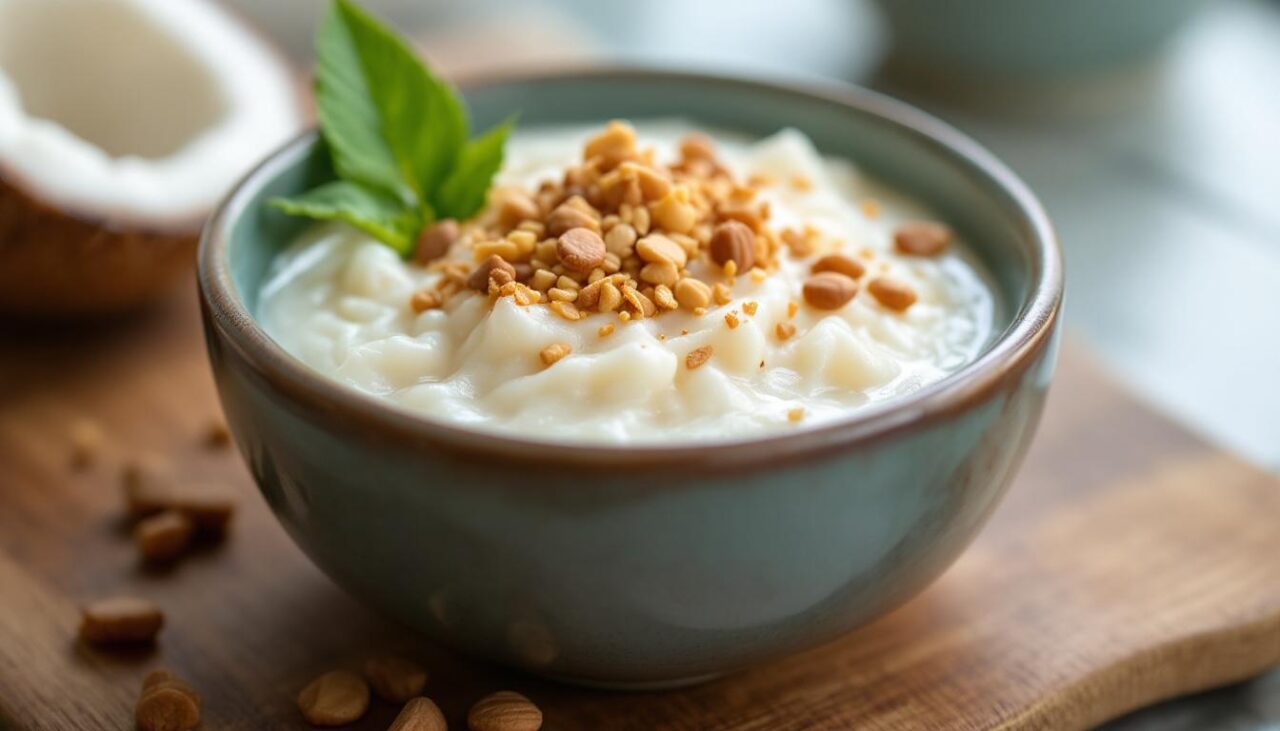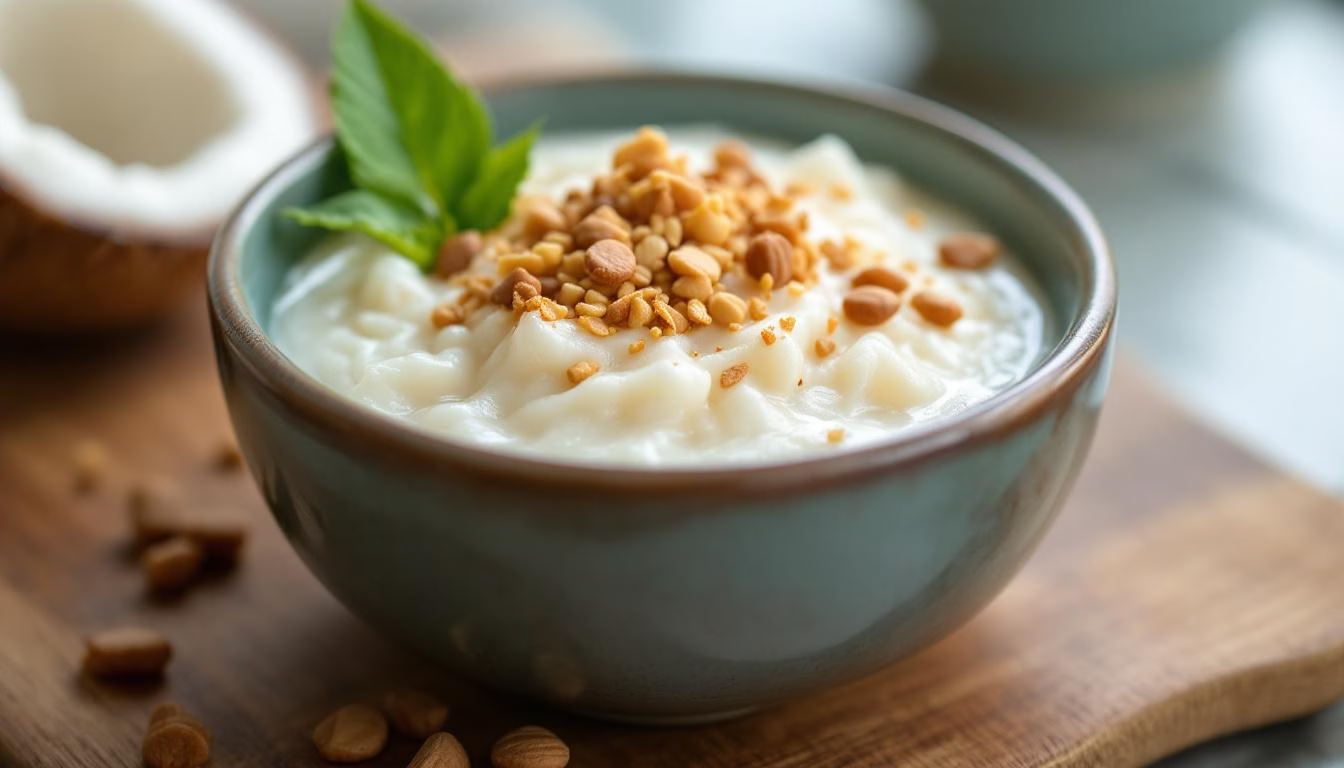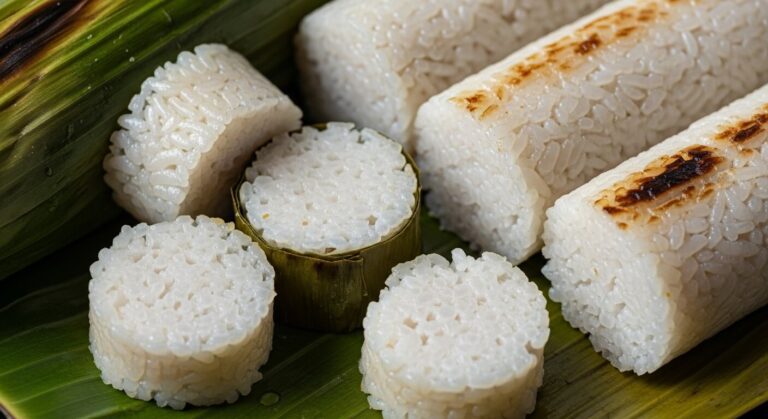Bubur Sumsum Recipe: Indonesian Coconut Porridge
The Silky Sweet Comfort of Bubur Sumsum (Sweet Indonesian Coconut Porridge) Recipe – I’ll never forget the first time I tasted bubur sumsum at a tiny warung in Jakarta, steam rising from a ceramic bowl while the morning heat was already making my shirt stick to my back.

Bubur Sumsum (Sweet Indonesian Coconut Porridge)
Ingredients
- 13.5 ounces coconut milk ((400 ml.) canned)
- ½ teaspoon vanilla extract
- 1 tablespoon palm sugar
- ¼ teaspoon salt
- 3 pandan leaves knotted
- ⅓ cup glutinous rice flour
- ½ cup palm sugar (or coconut sugar)
- ¼ cup water
- 12-16 biji salak (optional)
- Extra coconut milk (optional)
Instructions
- In a saucepan over low heat, warm the coconut milk, vanilla extract, palm sugar, salt, and pandan leaves for 4 minutes, just until simmering. Remove the pandan leaves.
- Whisk the rice flour into the coconut milk mixture. Continue cooking for 3-4 minutes until thickened and bubbling.
- In a separate small saucepan over high heat, whisk together the palm sugar and water. Cook, stirring, for 2-3 minutes until the sugar dissolves, forming a dark palm sugar syrup.
- Divide the rice porridge among 4 bowls, optionally adding 3-4 biji salak to each. Drizzle with the palm sugar syrup and, if desired, an extra drizzle of coconut milk.
Nutrition
The vendor, a woman who couldn’t have been more than five feet tall, ladled this pale green, silky porridge into my bowl with the kind of practiced grace that comes from doing something thousands of times.
She drizzled dark, molasses-like palm sugar syrup over the top in perfect spirals, then added a few mysterious little dumplings that looked like tiny potatoes.
“Biji salak,” she said with a smile, noting my confused expression.
That first spoonful was a revelation — creamy, fragrant with pandan, and just sweet enough to feel like a hug in a bowl.
The texture was unlike anything I’d experienced: silky and light, but substantial enough to feel satisfying.
The palm sugar syrup added this deep, caramel-like sweetness that played beautifully against the subtle coconut flavor.
And those little biji salak?
They turned out to be sweet potato dumplings that added the most delightful chewy contrast to the smooth porridge.
I’ve been chasing that perfect bowl ever since, and after countless attempts (and a few spectacular failures involving lumpy rice flour disasters), I’ve finally cracked the code for making this Bubur Sumsum (Sweet Indonesian Coconut Porridge) recipe at home.
The secret, I’ve learned, is patience — something I’m notoriously bad at, but this dish has taught me the virtue of low heat and gentle whisking.
Bubur Sumsum Indonesian Dessert: Silky Coconut Porridge Recipe
Bubur sumsum holds a special place in Indonesian cuisine as one of the country’s most beloved traditional desserts.
The name literally translates to “bone marrow porridge,” though thankfully, no actual bone marrow is involved — it’s called this because of its rich, creamy texture that’s supposedly reminiscent of the luxurious consistency of bone marrow.
This humble dessert represents the beautiful simplicity of Indonesian cooking, where a handful of quality ingredients are transformed into something magical through technique and patience.
Traditionally served warm, bubur sumsum is often enjoyed as a mid-morning snack or light dessert, though I’ve been known to have it for breakfast on particularly indulgent weekends.
The dish showcases two quintessential Indonesian flavors: pandan and palm sugar.
Pandan leaves, sometimes called the “vanilla of Southeast Asia,” impart a subtle, almost floral flavor and that distinctive pale green color.
Palm sugar, meanwhile, provides a complex sweetness that’s earthier and more nuanced than regular sugar.
Together with coconut milk and glutinous rice flour, these ingredients create a dessert that’s both comforting and sophisticated.
The Magic of Pandan and Palm Sugar
What makes this Bubur Sumsum (Sweet Indonesian Coconut Porridge) recipe truly special is the interplay between pandan and palm sugar.
Pandan leaves are absolutely essential here — they’re what give the porridge its signature pale green hue and that distinctive aroma that’s impossible to replicate with artificial flavoring.
If you can’t find fresh pandan leaves, frozen ones work beautifully, and they’re increasingly available at Asian grocery stores.
Palm sugar, on the other hand, is what elevates this from simple to sublime.
It has this deep, molasses-like complexity that regular sugar just can’t match.
The syrup you make with it becomes this gorgeous, glossy drizzle that not only adds sweetness but creates beautiful visual contrast against the pale porridge.
Mastering the Bubur Sumsum (Sweet Indonesian Coconut Porridge) Recipe
The key to perfect bubur sumsum lies in understanding that this is a dish that rewards patience and gentle handling.
Rush it, and you’ll end up with lumps or, worse, a grainy texture that’s nothing like the silky smoothness you’re after.
Ingredients You’ll Need
For the porridge:
- 13.5 ounces coconut milk (400 ml, canned)
- ½ teaspoon vanilla extract
- 1 tablespoon palm sugar
- ¼ teaspoon salt
- 3 pandan leaves, knotted
- ⅓ cup glutinous rice flour
For the palm sugar syrup:
- ½ cup palm sugar (or coconut sugar)
- ¼ cup water
For serving:
- 12-16 biji salak (optional but recommended)
- Extra coconut milk for drizzling (optional)
Step-by-Step Instructions: How to Make Authentic Bubur Sumsum: Indonesian Coconut Porridge
Let’s start cooking with the following steps:
Preparing the Coconut Base
Start by warming your coconut milk mixture over low heat — and I cannot stress this enough, keep that heat LOW.
In a saucepan, combine the coconut milk, vanilla extract, palm sugar, salt, and those knotted pandan leaves.
The knotting isn’t just for show; it bruises the leaves slightly, helping them release more flavor.
Let this mixture warm gently for about 4 minutes, just until you see the first tiny bubbles forming around the edges.
You want it to barely simmer, not boil.
Remove those pandan leaves now — they’ve done their job of infusing the mixture with that gorgeous flavor and color.
Don’t skip this step; leaving them in will make the next part much more difficult.
The Critical Rice Flour Step
Here’s where things get interesting, and where I’ve made my fair share of mistakes.
Whisk that glutinous rice flour directly into the warm coconut milk mixture.
The key word here is “whisk” — not stir, not fold, but whisk with purpose.
You want to break up any potential lumps before they have a chance to form.
Continue cooking for 3-4 minutes, whisking constantly, until the mixture thickens and starts bubbling.
You’ll know it’s ready when it coats the back of a spoon and has the consistency of thick cream.
If you’re getting lumps (been there!), don’t panic — just whisk more vigorously or strain the mixture through a fine-mesh sieve.
Creating the Perfect Palm Sugar Syrup
While your porridge is finishing up, make the syrup in a separate small saucepan.
Combine the palm sugar and water over high heat — this is the one time in this recipe where high heat is your friend.
Whisk constantly for 2-3 minutes until the sugar completely dissolves and you have a glossy, dark syrup.
It should be thin enough to drizzle but thick enough to coat the porridge beautifully.
Assembly and Serving
Divide the warm porridge among your bowls.
If you’re using biji salak (and you really should — they add such a lovely textural element), nestle 3-4 into each serving.
Drizzle generously with that gorgeous palm sugar syrup, and if you’re feeling extra indulgent, add another drizzle of coconut milk on top.
Pro Tips for Bubur Sumsum Success
After making this Bubur Sumsum (Sweet Indonesian Coconut Porridge) recipe more times than I care to admit, I’ve learned a few tricks that make all the difference.
Temperature Control is Everything
The biggest mistake I see people make is cooking this over too high heat.
Coconut milk can curdle if it gets too hot too fast, and glutinous rice flour can turn gummy if it’s shocked with high heat.
Keep everything at a gentle simmer, and you’ll be rewarded with that silky texture that makes this dessert so special.
Whisking Technique Matters
When you add the rice flour, whisk in a figure-eight pattern rather than just stirring in circles.
This helps incorporate the flour more evenly and reduces the chance of lumps forming.
If you do get lumps, don’t give up — just whisk more vigorously or push the mixture through a fine-mesh strainer.
Make-Ahead Tips
This porridge is best served warm, but you can make it a few hours ahead and gently reheat it.
Add a splash of coconut milk when reheating to restore the creamy consistency.
The palm sugar syrup actually improves with time, so feel free to make that component well in advance.
Sourcing Ingredients
Pandan leaves are increasingly available frozen at Asian grocery stores, and they work just as well as fresh.
For palm sugar, look for it in solid blocks or as a paste — both work beautifully.
If you absolutely can’t find palm sugar, coconut sugar is a decent substitute, though the flavor won’t be quite as complex.
Creative Variations on the Classic
Once you’ve mastered the basic Bubur Sumsum (Sweet Indonesian Coconut Porridge) recipe, there are several delicious variations worth exploring.
Coconut Flake Addition
Toasted coconut flakes make a wonderful garnish, adding textural interest and intensifying the coconut flavor.
Toast them in a dry pan until golden, then sprinkle over the finished porridge.
Fruit Variations
Some regions of Indonesia serve bubur sumsum with fresh fruit.
Diced mango or jackfruit work particularly well, adding natural sweetness and tropical flavor that complements the coconut base beautifully.
Different Sweetener Options
While palm sugar is traditional, you can experiment with coconut sugar for a slightly different flavor profile, or even a combination of palm sugar and a touch of honey for added complexity.
Texture Modifications
For those who prefer a thinner consistency, simply add more coconut milk.
For a richer version, substitute some of the coconut milk with coconut cream.
Some people also like to add a handful of tapioca pearls for extra chewiness.
What to Expect: Realistic Results and Troubleshooting
Let me be honest with you — your first attempt at this Bubur Sumsum (Sweet Indonesian Coconut Porridge) recipe might not be perfect, and that’s completely normal.
This is a technique-driven dish that improves with practice.
Your porridge should have a consistency somewhere between thick cream and pudding.
It should coat a spoon but still be pourable.
The color should be a lovely pale green from the pandan, and the flavor should be subtly sweet with that distinctive pandan aroma coming through.
The palm sugar syrup should be glossy and dark, providing beautiful visual contrast and deep, caramel-like sweetness.
If your porridge turns out lumpy, don’t despair — it still tastes delicious, and you’ll know to whisk more vigorously next time.
If it’s too thick, thin it with a bit more coconut milk.
Too thin?
Cook it a bit longer to reduce and thicken.
The beauty of this recipe is that it’s quite forgiving, and even imperfect results are still incredibly tasty.
The real joy of bubur sumsum lies not just in its taste, but in the meditative process of making it.
There’s something deeply satisfying about the gentle stirring, the gradual thickening, the way the pandan infuses the coconut milk with both color and fragrance.
It’s comfort food in the truest sense — both in the making and the eating.







